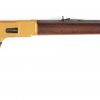John Browning’s 1911 is arguably the most iconic handgun of all time. Everyone knows what gun you’re talking about and can picture one in their head. A total of 2.7 million 1911s were made during the pistol’s unprecedented 75-year-run as the standard sidearm of the United States military. And that doesn’t take into consideration the massive number of civilian guns made in that same time frame and beyond, including current production.
In an effort to fulfill the need for massive amount of 1911s needed during World War II, unconventional companies did their patriotic duty and started making handguns. Union Switch and Signal put their railway equipment aside and made 1911s. Remington Rand put away the typewriter components and made 1911s. But the rarest of all 1911s from what we consider to be “World War II-era” were made by sewing machine maker Singer Manufacturing Company – and, interestingly enough, all of their guns were made well prior to the bombing of Pearl Harbor on December 7, 1941.
While the pistol came of age during World War II, it had already been in use for a few decades by that time. In an effort to test the feasibility of 1911 mass production, the United States Ordnance Department contracted with Singer in 1925 for an engineering study to see how many guns they could produce in a month. After the study was complete, it was determined that Singer could turn out as many as 25,000 1911s in a month.
In 1939, the Ordnance Department awarded a production study to Singer. This allowed them to fine-tune their production methods, come up with standard sizes for raw materials, and research the best production methods. The following year, under Educational Order W-ORD-396, Singer set out to make 500 1911A1 pistols. The goal of the order was a lofty one: eventual achievement of a production rate of 100 guns per hour.
Singer never hit the production rate goal, but they did fulfill their contract for 500 1911A1s. By 1941, Singer had divested themselves of the 1911 business and transferred their tooling and documentation to Remington Rand. As a result of this, Singers have the lowest production numbers of any 1911 model made in the United States.
Obviously, this makes them incredibly rare and very valuable, consistently selling for six figures each. Collectors often regard the Singer 1911A1 to be the “Holy Grail” of 1911s to add to their collection.

A number of known Singer guns have made their way through prominent collections over the years, and it always causes a stir when ones comes available. Such was the case with the Singer we sold in our May 2020 Extraordinary Firearms auction.
Being offered fresh to the market for the first time in just shy of a decade, we delighted to see it hammer for $129,150 – which was more than three times what it sold for in 2010.
In the end, the takeaway is clear: Singer pistols are exceptionally popular, and collectible firearms continue to be a solid investment.
–Logan Metesh



